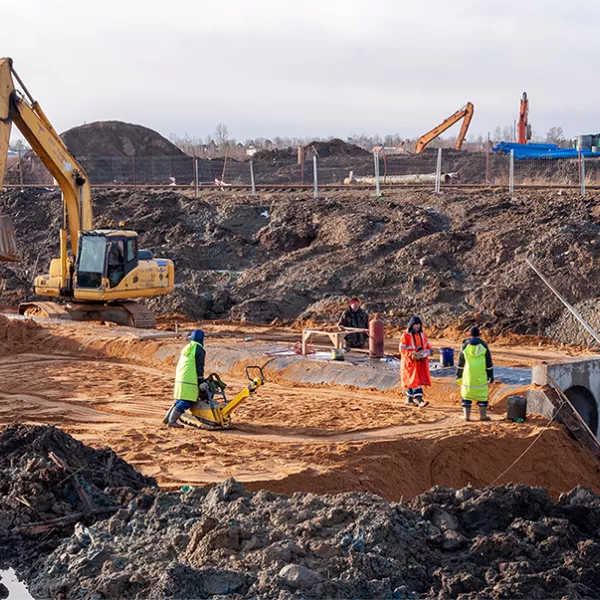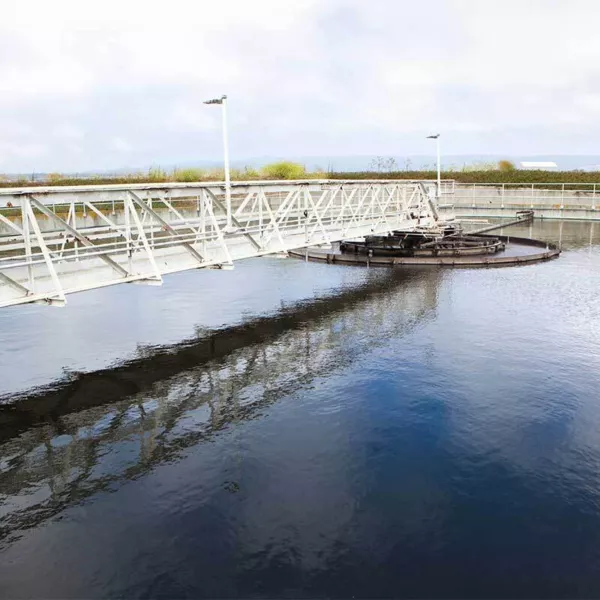DESOTEC and VITO develop an accurate method for the measurement of PFAS level adsorbed on activated carbon
DESOTEC and independent research organisation VITO have developed a more accurate and reliable way to measure PFAS ‘forever chemicals’ on spent activated carbon. Activated carbon is the most frequently applied technology to remove PFAS. With this methodology, companies can be sure that that their operations, including waste treatment, are compliant with the most recent regulations.
The challenges of measuring PFAS on activated carbon
The EU POPs Regulation governs the production and use of per- and polyfluoroalkyl substances (PFAS), as well as the treatment of waste containing these chemicals. Ensuring compliance is the responsibility of waste producers, including those of DESOTEC’s clients who are dealing with PFAS contamination issues – but we decided to help them out.
Activated carbon is one of the Best Available Techniques listed in the POPs Regulation to remove PFAS. This stipulates that once the carbon is saturated, it may be thermally reactivated if the PFAS concentration is below the limit of: 1mg/kg PFOA; 1mg/kg PFHxS; 50mg/kg PFOS. If the PFAS level exceeds the POPs threshold, the carbon must be disposed of, e.g. through incineration.
However, it is challenging for customers to assess how much PFAS will be on the activated carbon. Many industrial processes have variable input flows, and companies may be unsure of the loading capacity of the carbon.


A more accurate PFAS measurement method to reduce uncertainty and treat waste safely
DESOTEC therefore decided to develop a more accurate and reliable way to measure PFAS level on spent activated carbon to:
- Enable customers to identify the most appropriate way of treating their activated carbon PFAS waste to protect the environment and human health.
- Allow companies to demonstrate legal compliance, giving them confidence that their measurements will match those taken by the environmental authorities, thus avoiding hassle, fines or other enforcement action.
- Protect customers’ reputations, as the issue of PFAS is in the spotlight.
- Enable our R&D teams to assess installation performance and compare different carbon grades for various PFAS molecules.
VITO: a trusted partner for PFAS and measurement method expertise
While DESOTEC has unrivalled activated carbon knowledge, we needed a partner with expertise in developing measurement methods.
We chose to collaborate with VITO, who is at the forefront of analytical development and PFAS treatment in Europe.
VITO is a trusted partner of the Flemish government in Belgium, tasked to develop standard measurement methods and validate them with commercial laboratories. These methods are published on the energy and environmental information system (EMIS) for the Flemish Region (managed by VITO), then approved by the Flemish authorities for official use.
VITO is also a member of the EU Working Group for PFAS measurement method development, and works closely with the USA’s EPA.
DESOTEC and VITO are both based in Flanders and have collaborated productively on previous projects, making this an ideal partnership.
PFAS measurement method development: a thorough process
The six-month project consisted of two broad challenges:
Step 1: Optimising extraction. PFAS adsorbed onto activated carbon is a solid matrix. Therefore, an extraction step is necessary; this needs to be as efficient as possible in order to get as much PFAS out of the carbon as possible. DESOTEC’s expertise in activated carbon was crucial here.
Once extracted and transferred into a liquid phase, the PFAS was measured using liquid chromatography tandem mass spectrometry (LC-MS). Here, VITO’s expertise and equipment were critical.
Step 2: Validation experiments. VITO’s expertise was invaluable in defining a set of experiments to assess five parameters: detection, accuracy, linearity, reproducibility and uncertainty.
There were four rounds of experiments to test different solvents and conditions to optimise extraction. In each round, the recovery for the different methods was calculated, determining which method was used in the following rounds.
Round 1:
- Two solvents : acetonitrile and methanol.
- Sonication versus shaking for extraction.
- Length of time for shaking/ sonication.
- One carbon type.
- One fixed concentration.
Round 2:
- Two different spiking concentrations.
- Length of sonication.
- Addition of acid and base (formic acid and ammonium acetate) to the solvent.
Round 3:
- Three spiking concentrations.
- Isotopes to evaluate accuracy of extraction methods.
- Two-step extraction method using one solvent and a binary mixture (only acetonitrile, or acetonitrile/hexane (50:50), or acetonitrile + hexane).
- Two carbon types: one coconut and one coal-based.
Round 4:
- Three solvents (acetonitrile + hexane (two steps) or alkaline methanol (NH3)).
- Three activated carbon grades: two coal-based and one coconut-based.
- One concentration.
Two initial validations were conducted: one at VITO, and an internal validation at DESOTEC. Activated carbon samples were also sent to commercial laboratories for further validation.
See the method in this infographic:

General conclusions from the PFAS measurement method development
The tests yielded some important findings:
- Shorter chain PFAS were easier to extract than longer chains.
- Extraction yields were higher for certain carbon types, e.g. coconut based. (However, they are well suited to treating PFAS when used in the field, as loading capacity and extraction efficiency are not the same thing.)
- Accuracy of the new method was considerably higher than existing methods at around 20%. While this may appear low, it is important to note that PFAS is found only in ultra-low concentrations, making detection very difficult.
Why is this PFAS measurement method innovative?
Two existing methods used in Flanders are:
1. CMA/3/D: for soils and sediments.
2. CM/A3/O: for soil improvers.
Both use one extraction step followed by one concentration step, followed by measurement on LC/MS device.
Our new method uses three extraction steps and one concentration step, followed by the same LC/MS measurement as in the existing methods above. The solvents used are the same.
This ensures that as much PFAS is extracted from the activated carbon as possible, giving far more reliable and accurate results, and providing reassurance to our industrial customers on how best to treat their PFAS-waste.
The draft method now available
This draft method is now available for commercial laboratories to use for the analysis of PFAS on activated carbon. It will become mandatory upon ratification by the Flemish government in January 2025.
DESOTEC and VITO will continually seek to optimise, review and update the method in the future to make sure PFAS are accurately measured and then safely eliminated to protect the environment.
Related content
-
A sustainable solution to remove ‘forever chemicals’ from wastewater & air emissions for good
The omnipresent and potentially toxic per- and polyfluoroalkyl substances (PFAS) have quietly permeated our world. For this reason, the EU persistent organic pollutants (POPs) regulation and other legislations are restricting the use and emission limits of these molecules in industrial wastewater and air emissions. However, DESOTEC has developed a secure method, compliant with the POPs regulation, to remove PFAS and enables manufacturers to permanently and sustainably address the persistent challenge of ‘forever chemicals’. -
Removing and destroying residual PFAS in groundwater
Explore a chemical production company's challenge in Belgium as they tackle PFAS contamination during a vital piping replacement project. With strict water quality regulations, they turn to DESOTEC for expertise in PFAS purification after discovering high PFOS levels in groundwater. -
Purifying wastewater of PFOS and other PFAS
Combat the threat of PFAS contamination with DESOTEC's sustainable filtration solutions, ensuring regulatory compliance and safeguarding environmental and human health.
Contact DESOTEC and VITO
To find out more about this draft method or our PFAS removal solutions, please contact DESOTEC
Contact us nowContact DESOTEC and VITO
To find out more about this draft method or our PFAS removal solutions, please contact DESOTEC
Contact us now-
Restricted Chemicals
Firms handling restricted chemicals need reliable solutions. Our filters treat POPs, PFAS, SVHC and CMR chemicals from air and water in a safe and sustainable manner. -
Our filtration solutions
We offer a wide range of filter models and carbon grades to suit your industrial water or air purification requirements. -
Your sustainability journey
We care about protecting our air, water and soil for future generations, just like you. Our filtration solutions help you meet environmental standards, reducing your carbon footprint.





